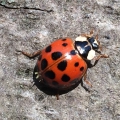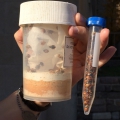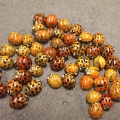Ladybug, ladybug and more ladybugs
Published
Categories
Blog Post
Every fall, there is a period when people see lots of ladybird beetles flying about or congregating. Unlike our native species which are adapted to Canadian winters, the Asian Multicoloured Ladybird Beetle (Harmonia axyridis) cannot survive at temperatures below -5oC and has to find a place to hibernate, usually indoors. They will scout out the best south facing walls of buildings (like here at the ROM) and enter through small gaps.




Harmonia axyridis and Brenna Wells holding some samples that were collected for a gallery exhibit on non-native species. Photos by A Guidotti
gallery exhibit on non-native species. Photos by A Guidotti
Since they aggregate indoors to hibernate, you may find large numbers in your home. While you may consider them a nuisance, they do not feed during the winter. Also unlike native species, they have been known to bite if handled. I've held many though and haven't been bitten yet!
Introduced intentionally by the US government in the 1970s to combat aphid populations, the Asian Multicoloured Ladybird Beetle is now the predominant species of ladybird beetle in North America. It was first recorded in Canada in 1994. This species occurs in a wide variety of colour forms, but all have a white M-shaped mark on the pronotum (behind the head). They may have no dots, or a few dots or many dots, so you can't count them to figure out the species! Ladybird beetles are beneficial. This species is no exception, since they feed on aphids which are plant feeders.
On the negative side, this species appears to be out-competing our native species. Once-common native species have become rare, some possibly even extirpated. Some examples include the nine-spotted ladybug (Coccinella novemnotata), the transverse ladybug (Coccinella transversoguttata) and the two-spotted ladybug (Adalia bipunctata). Ontario has recorded over 80 species of ladybird beetles but now the most often seen one is the Asian Multicoloured Ladybird.
To record native ladybird sightings visit www.lostladybug.org



